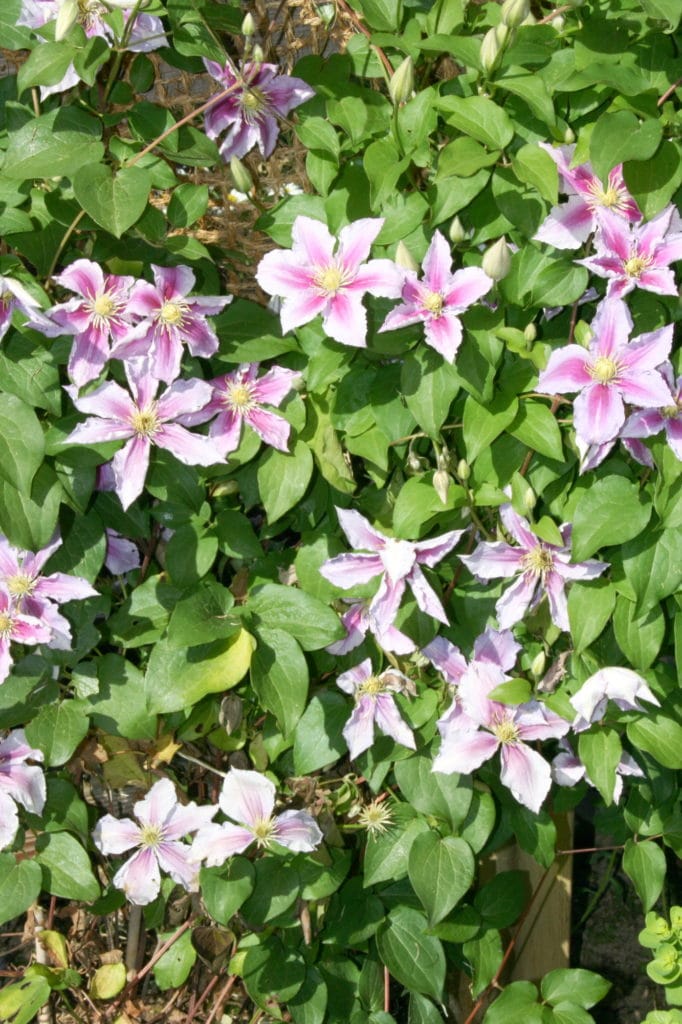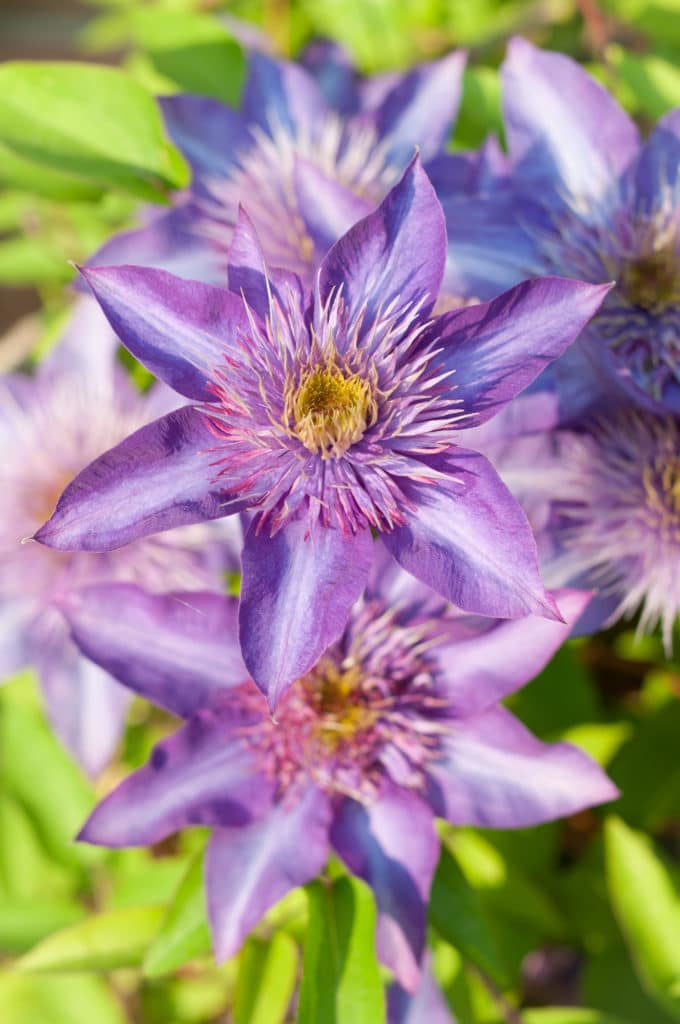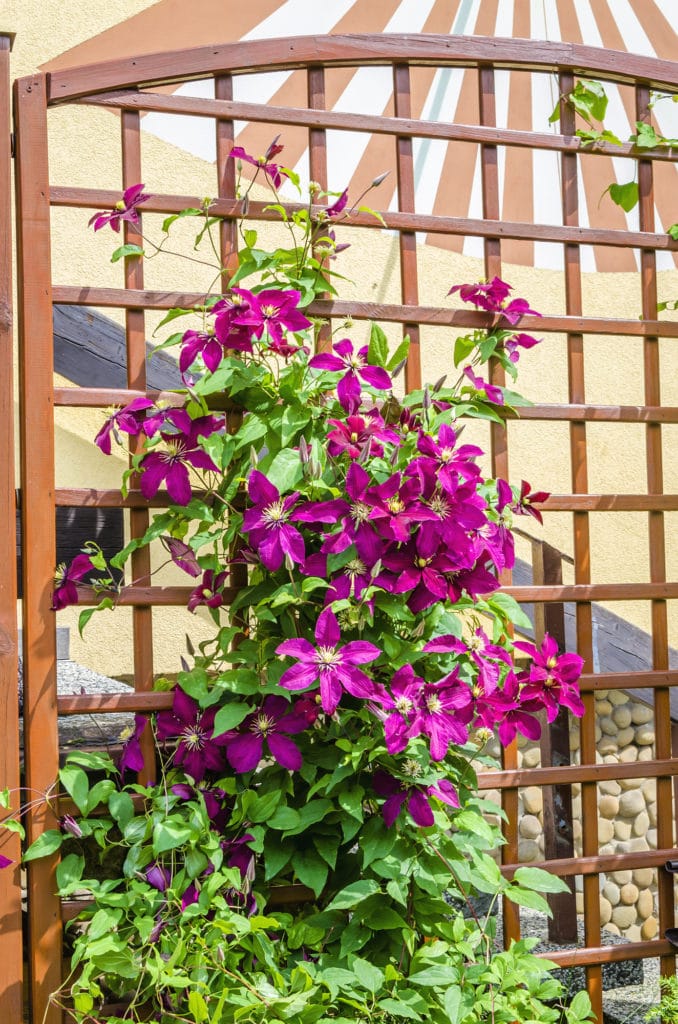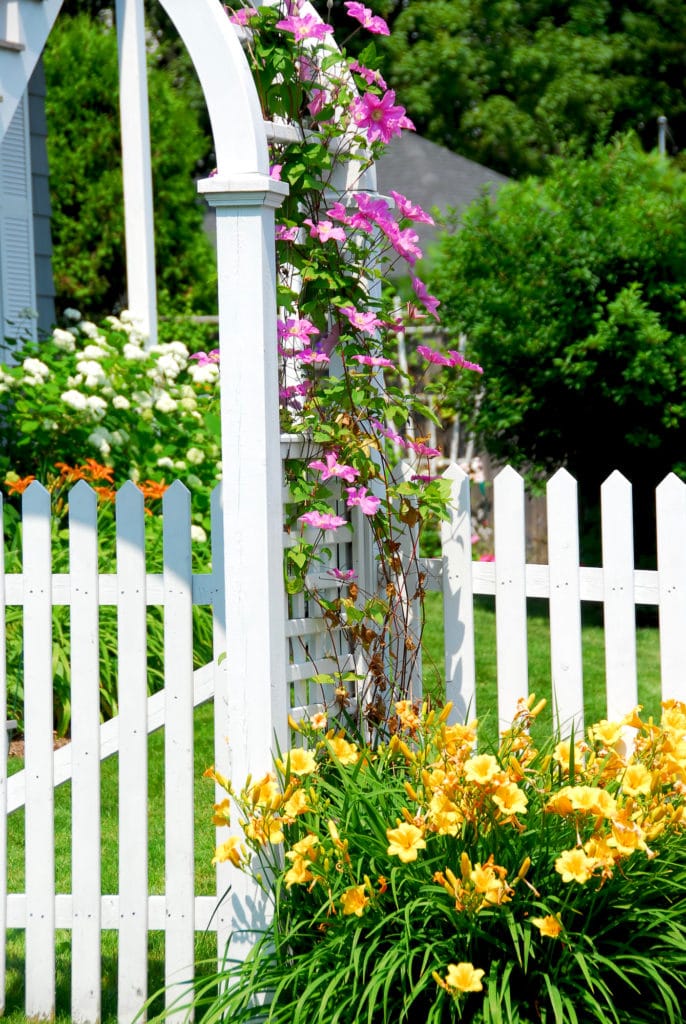How to Grow Clematis Vine
Clematis is the workhorse of so many yards and gardens across the country.
Gardeners and homeowners alike love growing clematis vines because they add decorative detail to their home and they’re low-maintenance.
(This post may contain affiliate links).
This beautiful, lustrous vine is actually Greek for “climbing plant”. It can effortlessly give a property so much character, which is why it’s so beloved!
Luckily for us, it’s easy to maintain. You simply need to provide it with a steady structure to climb on, and you need to understand its basic growing needs.
Clematis can be found in over 300 varieties, but you’ll want to choose a variety that grows well in your zone.
Clematis flowers bloom from Spring to Fall, which makes them appealing for gardeners of all levels.

How to Plant Clematis Vine
Clematis can take several seasons to mature and grow, so if you’d like faster results, try purchasing a clematis plant from your local nursery that’s at least a few years old (2 years minimum).
You can purchase this flowering vine in shades of purple, lavender, blue, red, white, and yellow.
Either choose your favorite color or choose the one that looks the healthiest.
Keep in mind that your plant may grow up to 20 feet, so make sure you designate a spot that can accommodate it, otherwise you’ll have to inhibit its growth so that it doesn’t overtake your wall or garden.

Plant your clematis in an area that gets at least 6 hours of direct sunlight each day. This is very important!
While clematis can tolerate part shade (especially if you live in a very hot area), it won’t perform as well as it could if it were under full sun.
How to Care for Clematis Vine Using a Trellis
Not sure what I mean by trellis? You might not have heard this word before but you’ve definitely seen it in other people’s gardens.
Trellis is essentially pieces of wood or iron interwoven together to act as a supportive structure for growing plants. (As seen in the picture below).

Once you plant your clematis a few inches from your trellis, you’ll need to help it understand where to grow and climb.
Don’t worry, this isn’t difficult to do and clematis vines learn very quickly.
The easiest way to do this is by utilizing tall wooden sticks. Simply lean a few sticks against the trellis and then dig them into the soil, near the base of the plant.
As the plant grows, carefully attach the vine to the sticks and the trellis so that it stays in place and grows upwards.
Attach the vine using gripper clips– they’ll save you a lot of time and energy!
Soil Needs in Clematis Care
Clematis thrives in moist, well-drained soil that isn’t too acidic. Work organic fertilizer into the soil BEFORE you transfer your plant from its container.
You’ll want to plant the roots several inches deep (about 4 inches).
Remember, the plant’s roots need ample moisture and nutrients so they can establish themselves in their new home.
Be careful, however, not to overwater the plant. If you feel that the soil has gone dry, water generously but make sure you don’t end up flooding the plant.
To help retain moisture and keep the soil cool, try adding mulch or bark around the plant. The roots will start to settle over the next few weeks!

TIP: Growing a clematis plant in soil that isn’t too acidic is key. Test your soil with a pH meter tester and if it’s too acidic, simply add a bit of garden lime to adjust the pH level.
How to Fertilize and Prune Clematis Vine
Clematis vine benefits tremendously from regular fertilizing. Fertilize your soil in the spring with a low-nitrogen fertilizer. After that, you can fertilize with a 10-10-10 fertilizer every month until Fall.
As far as pruning is concerned, clematis is not a plant you want to neglect! Pruning will greatly increase the vine’s vitality and lifespan.
Deadheading old stems will promote regrowth and encourage your buds to bloom beautiful flowers.
How do you know when it’s time to prune your clematis? The answer is simple: prune the branches AFTER they finish flowering.
Once you see dead flowers wilting away, go ahead and start pruning.
The deadwood should be easy to spot – it’ll look less vibrant than new growth. However, as you prune back the deadwood, be careful not to disturb healthy buds.
Next spring’s blooms are determined and formed this year, so harming healthy buds is a sure way to kill off the flowers that should pop up next year.
If you find that your flowers aren’t blooming the way they used to, then you might not have pruned them down enough OR you mistakenly shaved off a healthy bud.
Just as with other plants, like the peony or lilac bush, clematis will perform much better the following year if you drastically prune down the branches at the end of the growing season.
TIP: If you wish to transplant your clematis, early Spring is best.
Clematis Disease
Unfortunately, clematis can fall prey to a disease called Clematis Wilt.
If you notice that entire branches are turning black, then your clematis has likely been infected with this disease.
There’s a simple fix: remove the black wood promptly by cutting it down until you reach healthy wood.
Quickly dispose of the affected wood. DO NOT leave the infected wood laying around in your garden and don’t use it as compost – this can spread the disease to your other plants.
Thoroughly clean your gardening tools and pruning shears, too.
Growing Other Low-Maintenance Perennials
That covers the basics of what you need to know in order to grow and care for clematis vine.
As you get more comfortable with growing clematis, you might wonder why you didn’t start sooner, as this plant can take a yard from boring to beautiful in a span of a few months.
It’s like giving your house a mini facelift.
If you’re looking for other low-maintenance perennials to adorn your garden with, check out this list of 18 different varieties – there are so many beautiful choices.
Does your yard have a lot of shady areas? Several perennials prefer full sun, growing vigorously under 6 or more hours of sunlight each day.
You’re bound to find a few that will go perfectly with your garden.
Happy gardening!


Just brought a clematis do I need to cut it right down at the ground and put hay over it
Hi Carolyn,
No, you’ll want to prune your clematis to remove dead wood but don’t cut it all the way to the ground. Different varieties of clematis bloom at different times, so it’s important to know your group/variety. Do you know if the clematis has already bloomed?
how do I take care of my new clematis for the winter? do I cut it right dow to the ground then put hay on top of it?
And yes, when the weather reaches freezing temperatures, place mulch or hay around the base of the plant.
I have a white clematis it get morning sun it has been in the same spot for 3 years has grown in height but did not bloom, what could be the problem?
Hi Carolyn,
Did you use fertilizer? The fertilizer may have had too much nitrogen; that’s a common culprit. Also, clematis needs about 6 hours of sunlight because that’s what helps produce the blooms, as well as proper pruning.